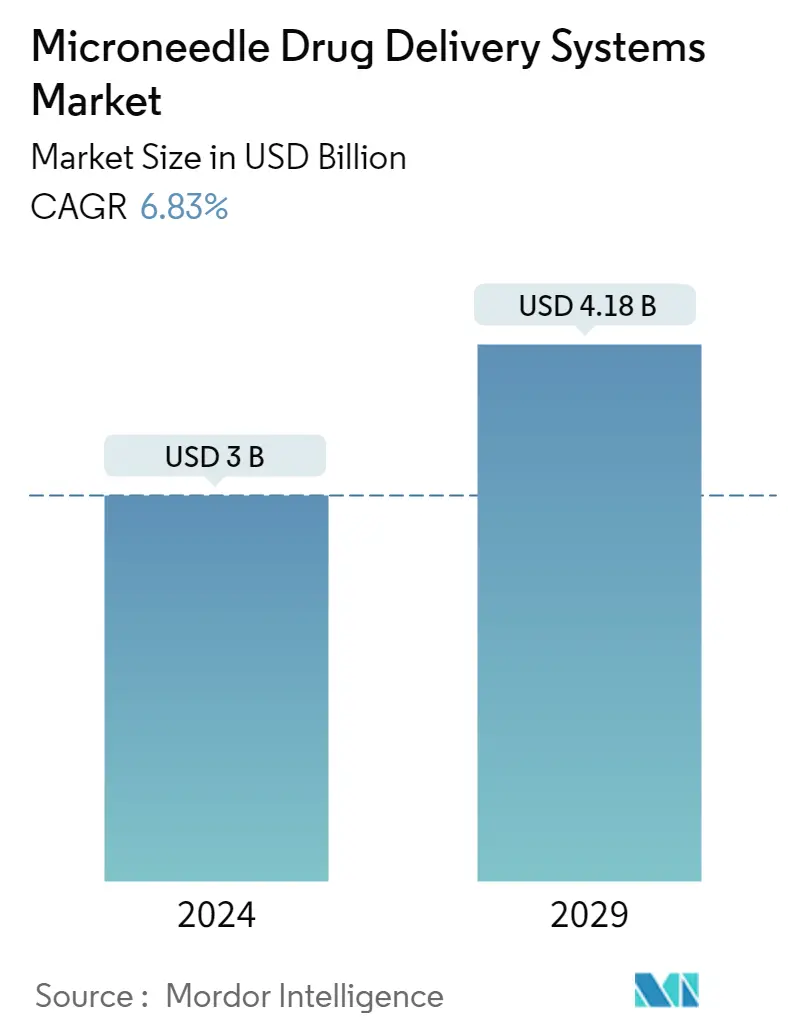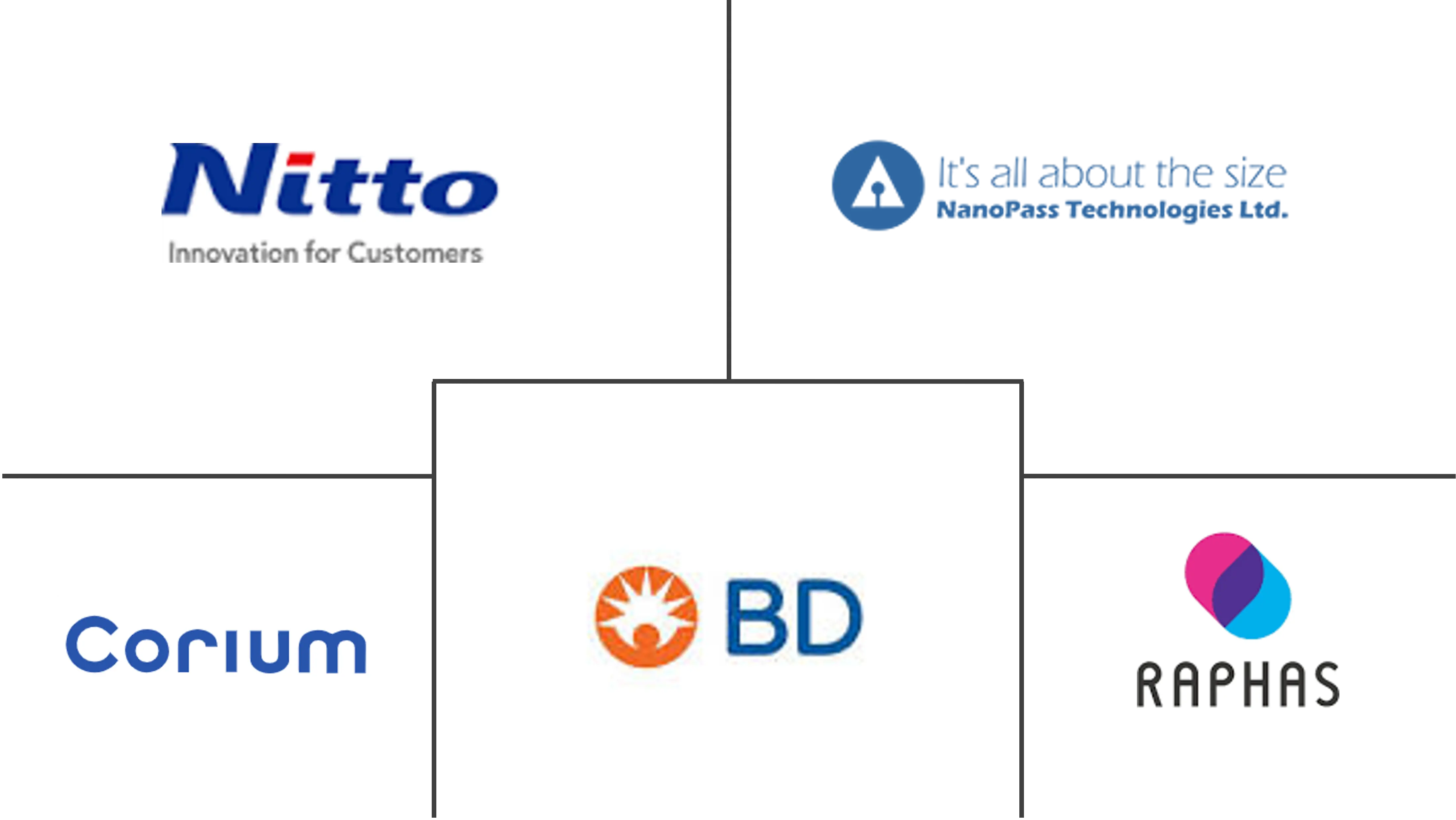Market Size of Microneedle Drug Delivery Systems Industry

| Study Period | 2019 - 2029 |
| Market Size (2024) | USD 3.00 Billion |
| Market Size (2029) | USD 4.18 Billion |
| CAGR (2024 - 2029) | 6.83 % |
| Fastest Growing Market | Asia-Pacific |
| Largest Market | North America |
Major Players
*Disclaimer: Major Players sorted in no particular order |
Need a report that reflects how COVID-19 has impacted this market and its growth?
Microneedle Drug Delivery Systems Market Analysis
The Microneedle Drug Delivery Systems Market size is estimated at USD 3 billion in 2024, and is expected to reach USD 4.18 billion by 2029, growing at a CAGR of 6.83% during the forecast period (2024-2029).
COVID-19 impacted the growth of the microneedle drug delivery market. The lockdown measures imposed by the government and the shutdown of hospitals and clinics resulted in disrupted services for patients suffering from chronic and lifestyle-related diseases. The rising COVID-19 cases increased the focus of companies and institutions to develop fingertip-sized skin patches for the delivery of drugs during the pandemic. For instance, according to an article published by ACS, in May 2020, the researchers at the University of Pittsburgh Medical Center and the University of Pittsburgh tried to develop a microneedle array (MNA), a fingertip-sized patch with 400 microscopic needles that inject spiked protein fragments into the skin, where an immune response is most potent. Thus, the use of microneedles for COVID-19 vaccination impacted the market's growth during the pandemic. Moreover, the focus of the companies is shifting toward developing microneedle patches and drug delivery systems. For instance, in October 2021, Tapemark partnered with 10X Technology to commercialize MicroDerm, which uses microneedle technology to deliver a wide range of drugs via transdermal patches. The patch's tiny microneedles penetrate the skin just deep enough for the medication to reach the bloodstream without causing discomfort or inconvenience as compared to hypodermic needles. Thus, such developments are expected to increase the market's growth over the forecast period.
The growth of the market is being driven by things like the growing number of chronic diseases and lifestyle-related disorders, more research on painless drug delivery, advances in technology, and the growing demand for a safer alternative to traditional hypodermic injections.
The increasing prevalence and burden of chronic diseases around the world are driving the demand for effective and advanced drug delivery systems, which is the key factor driving market growth. For instance, according to the BHF England Factsheet, published in January 2022, about 6.4 million people were living with cardiovascular diseases in England in 2021. Also, as per the 2022 statistics published by the BHF, around 7.4 million people will be living with heart and circulatory diseases in the United Kingdom in 2021. So, the high number of people with cardiovascular diseases drives up the demand for controlled or slow drug release, which is expected to drive market growth over the next few years.
Additionally, according to 2022 statistics published by the IDF, about 537 million people worldwide were suffering from diabetes in 2021, and this number is projected to reach 643 million and 784 million by 2030 and 2045, respectively. Thus, the expected increase in the diabetic population increases the demand for microneedle technology to deliver insulin through the stratum corneum of the skin in a minimally invasive and painless way. This is anticipated to augment market growth over the forecast period.
Furthermore, the rising research studies related to microneedle drug delivery are expected to raise its adoption during drug delivery, vaccine formation, or the treatment of various diseases through microneedle systems. This is also contributing to market growth. For instance, according to an article published by the Journal of Pharmaceutical Innovation in October 2021, it has been observed that microelectromechanical system (MEMS)-based microneedles are an innovative way of drug delivery that increases the permeability of the skin. It creates microscopic pores within the skin, allowing for passive drug diffusion and dermal microcirculation. This phenomenon aids in the effective permeation of drugs. As a result, the benefits of microneedles are expected to drive market growth over the forecast period.
Moreover, the rising company activities in developing microneedle products and increasing product launches are also contributing to the market growth. For example, in January 2022, Zosano Pharma announced that clinical data showed that a trivalent influenza vaccine made for its transdermal microneedle system was just as effective as a higher dose of the same vaccine injected into the muscle.
Therefore, owing to the aforementioned factors, such as the high burden of chronic and lifestyle-related disorders and the increasing adoption of microneedle drug delivery systems, the studied market is expected to grow over the forecast period. However, the limited number of approved products, as well as the complications or risks associated with microneedles, are likely to stymie market growth over the forecast period.
